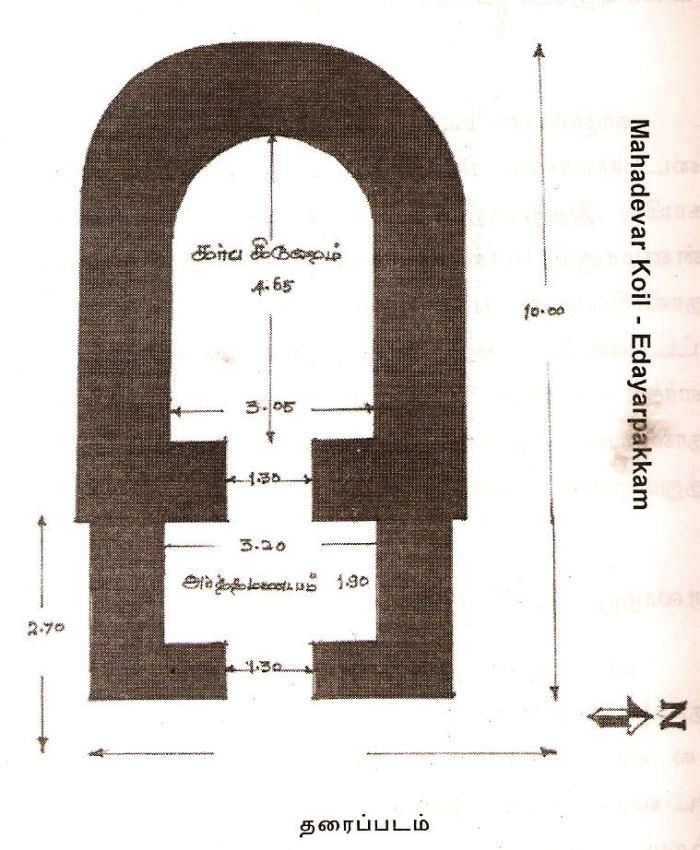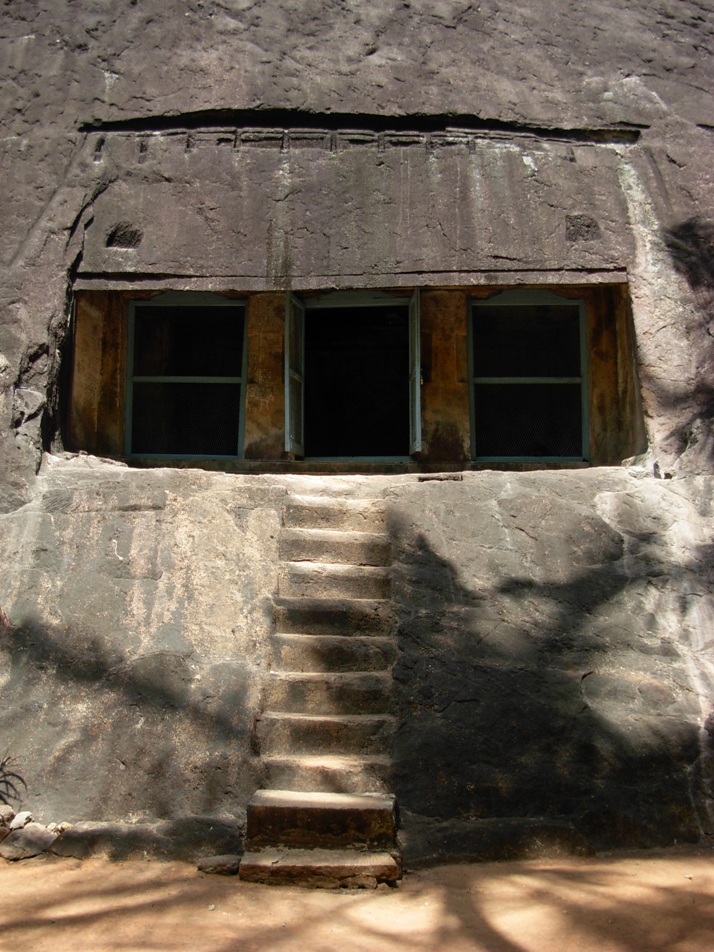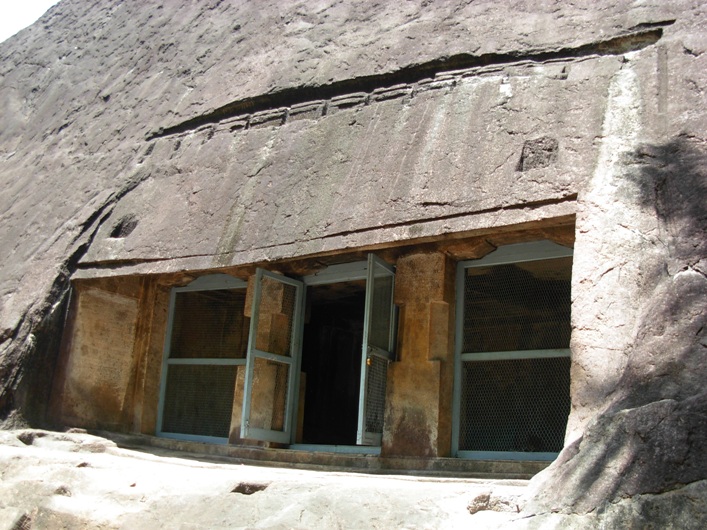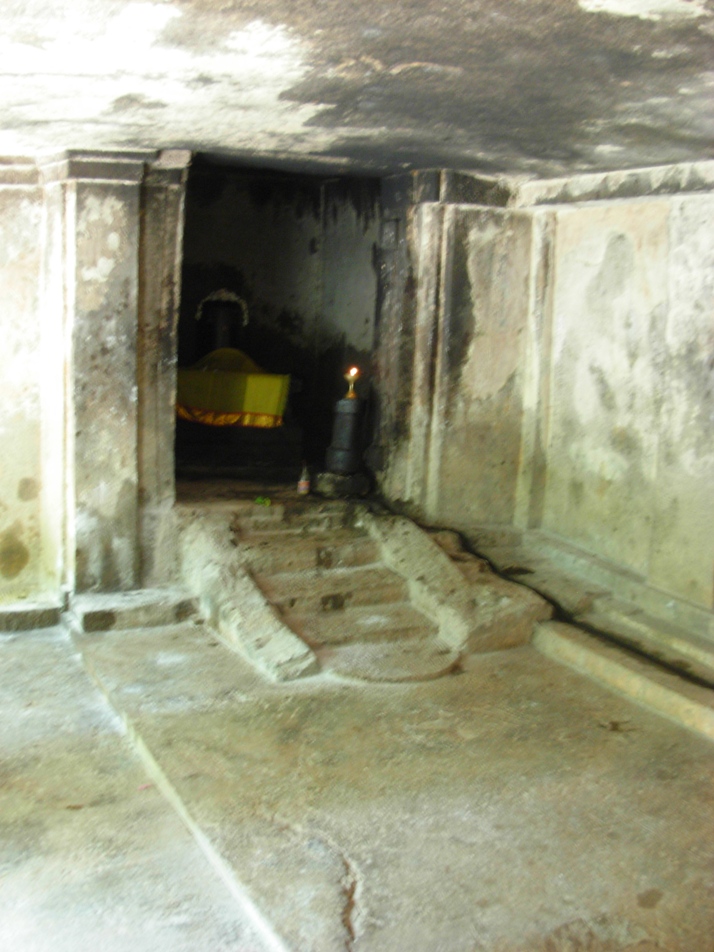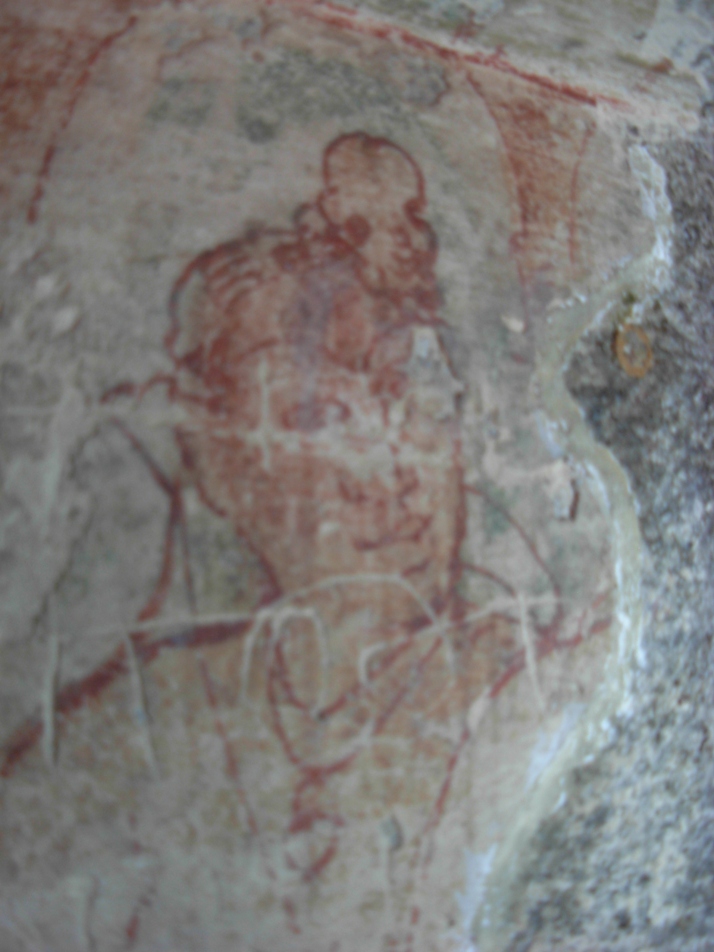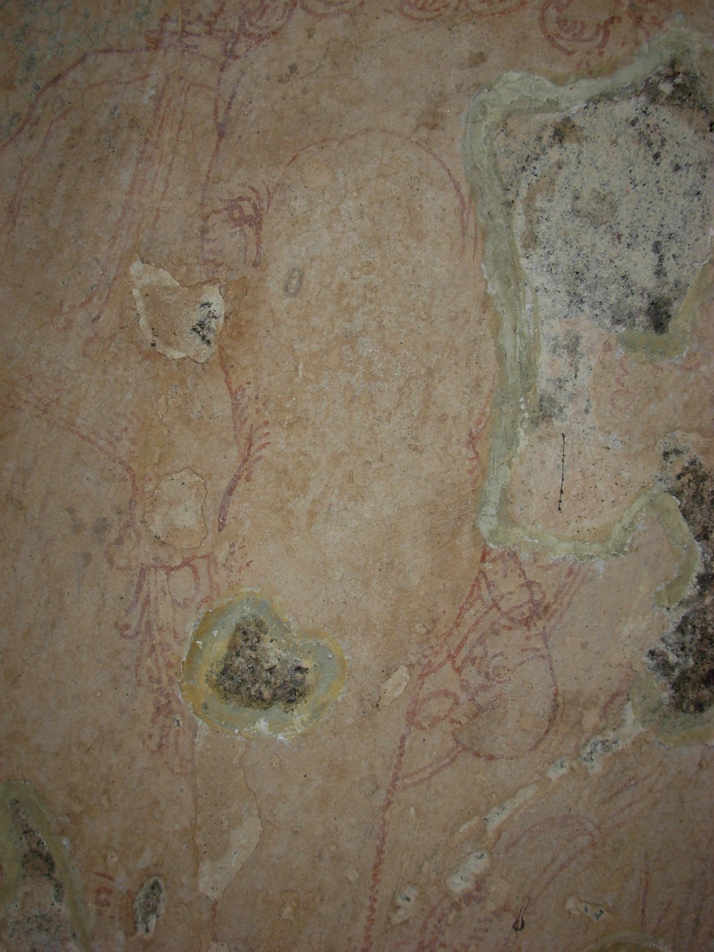 |
| Tirumundeesvaram Temple (Wikimapia) |
Panuval
Bookstore, Thiruvanmiyur is popular for books on environment and
society and for its series of weekly, monthly lectures and discussions
on literature, cinema, society, economics and politics at its premises.
It has also organized three "
One day Archaeological Educational Tour" to historical and
archaeological monuments. The fourth one day tour heritage tour was
organized on 04th October 2015 and planned cover four places in Thiruvennainallur and Tirukoyilur taluks, Villipuram district in Tamil Nadu: Gramam (Tirumundeesvaram) கிராமம் (திருமுண்டீஸ்வரம்),
Tiruvennainallur (திருவெண்ணெய்நல்லூர்), Tirukoyilur (திருக்கோவிலூர்), Jambai Dasimadam
hillock (ஜம்பை தாசிமடம் குன்று) and Jambunatheshwarar Temple (ஜம்புநாதேஸ்வரர் கோவில்). It was planned to hire a bus and
accommodate around 30 participants.
Panuval also ensured the participation of Dr. Padmavathi Anaiappan, retired Senior Epigraphist, Tamil Nadu State Archaeology Department, Mr. C.Veeraraghavan, ancient historian, freelance archaeologist and epigraphist and Mrs. Mangayarakarasi Veeraraghavan. I had the chance to participate in this one day tour. However we could spent our entire day in visiting two places only i.e, Gramam and Jambai Dasimadam
hillock and Jambunatheshwarar Temple.
 |
| Dr. Padmavathi Anaiappan: Explaining the History |
We
have commenced our day from Panuval Bookstore, Thiruvanmiyur by 06.30
am. After number of pick-ups at several points, we proceeded straight on
the NH45 towards Villupuram. We stopped on the Highway at the roadside
and finished our
packed breakfast (Hot-Chips Mini Breakfast) under the shady tree. The NH 45 was looking
excellent highway for pleasant morning travel. Mr.C. Veerraghavan and
Mrs.Veeraraghavan joined with us at Villupuram by-pass. After travelling
about 5 km, we took the right turn at Arasur crossing and proceeded
further on the road leading to Thiruvennainallur
enroute to Tirukoilur. After passing through the railway level crossing,
we reached our first destination, the village Gramam and parked our
vehicle before Sri Sivaloganathar temple.

Gramam (கிராமம்) is a village
in Thiruvennainallur taluk (திருவெண்ணைநல்லூர் வட்டம்), Villupuram district (விழுப்புரம் மாவட்டம்), Tamil Nadu, India.
The village is located on the southern bank of the river Malattaar (மலட்டாறு). Malattar is said to be the old bed of Thenpennai river. The historical Tirumundeeswaram (Mouli Gramam) village is described to have been located on the
southern bank of the Thenpennai river. The Thenpennai River (aka Dakshina Pinakini in Kannada) covers 105 km in Villupuram district. It is the main source for irrigating over 25000 acres in Villupuram district. The Gramam village is at the geographic coordinates of 13.093 N latitude and 80.292 W longitude. The rural village is part of Gramam village panchayat and as per census
2011 it has a population of 3,048 people and 68.43 % literacy rate. The main occupation of the area is agriculture and allied activities. It is located 16 km towards South from District head quarters Viluppuram,
3 km from Arasur, 5 km from Thiruvennainallur, 21 km from Thirukovilur and
190 km from State capital Chennai.
Location: Gramam near
Tiruvenneinallur . (Nadu Naadu (நடு நாடு)
Historical Name: Mundeeswaram (முண்டீஸ்வரம்)
Shiva: Sivalokanathar (சிவலோகநாதர்), Mundeeswarar (முண்டீஸ்வரர் ), Mudiswarar (முடீஸ்வரர்).
Ambal: Soundaryanayaki (சௌந்தர்யநாயகி), Kanarkuzhali (காணார்குழலி), Selvambikai (செல்வாம்பிகை).
Holy Tree (Vriksham): Vanni (வன்னி). Prosopis tree (in English). Botanical Name: Prosopis cineraria (Family: Fabaceae)
Holy Water (Theertham): Mundaka Theertham (முண்டக தீர்த்தம்)
Devaram Hymn (தேவார பதிகம்) : Devaram hymns of saint Tirunavukkarasar (திருநாவுக்கரசர்).
This shrine is the 19th Lord Shiva Temple in Nadunadu region praised in Devaram hymns (19வது நடுநாட்டுத் தேவார தலம்).
Hymns (Patikam) of Saint Tirunavukkarasar Devaram mentions this shrine as Tirumundeeswaram (திருமுண்டீச்சுரம்)
'திருமுண்டீச் சரத்து மேய
சிவலோகன் காணவனென் சிந்தை யானே.'
 |
| Entrance |
The inscriptions of Parantaka Chola I address this shrine as 'Tirumudiyur.'
The inscriptions of Rajendra Chola I record the name of this shrine
brahmadeyam of Mudiyur-nadu (முடியூர் நாட்டுப் பிரமதேயம்) and was
forming part of the subdivision of Tirumunaipadi Nadu (திருமுனைப்பாடி நாடு) in
Jayangonda-Solamandalam (ஜெயங்கொண்ட சோழமண்டலம் ) province. According to the inscriptions of Aditya
Karikalan aka Aditya II, Kulotunga I and Kulotunga II, this shrine was
known as Parantaka chaturvedhi-mangalam (பராந்தக சதுர்வேதிமங்கலம்) of Mutiyur-nadu (a subdivision) of
Tirumunaipadi Nadu (திருமுனைப்பாடி நாடு) in Jayangonda-Solamandalam. Rajaraja II called this
shrine as Kulotunga Chola Chaturvedhi-mangalam (குலோத்துங்க சோழ சதுர்வேதிமங்கலம்) of Mutiyur-nadu. The
place according to R.P.Sethupillai (இரா.பி.சேதுப்பிள்ளை) was also called as Mouli Gramam (மௌலி
கிராமம்) in Sanskrit. Later it was transformed to as just 'Gramam' after
omitting prefix 'Mouli.' The current name of this shrine is
Tirumundeeswaram.
The
prime deity Sivalokanathar was addressed with different names in
different inscriptions: Parantaka Chola I inscriptions called the Lord
as 1. Sri-Arruttali (ஸ்ரீ ஆற்றுதளி), 2. Sri-Arruttali-Mahadeva (ஸ்ரீ
ஆற்றுதளி மகாதேவா), 3. Sri-Arruttali-Perumanadigal (ஸ்ரீ ஆற்றுதளி பெருமானடிகள்), 4. Sri-Arruttali-mulasthanattu-Perumanadigal
(ஸ்ரீ ஆற்றுதளி மூலஸ்தானத்துப் பெருமானடிகள்), 5. Sriyarruttali-Perumal
(ஸ்ரீயாற்றுத்தளி பெருமாள்). Rajara Chola II preferred to call the Lord
as Sri-Arruttali-Aludaiyar
(ஸ்ரீ ஆற்றுதளி ஆளுடையார்). Jatavarma Sundarapandya I called the Lord as
Bokkanankuduttaruliya-Nayanar (பொக்கிஷங்கொடுத்தருளிய நாயனார்) and Mulasthanam-Udaiyar Bokkanankuduttaruliya-Nayanar (மூலஸ்தானத்து உடையார் பொக்கிஷங்கொடுத்தருளிய நாயனார்).
 |
| View from North-east corner |
The Chola prince Rajaditaya, when stationed to guard the Chola garrison in Gramam village, crowned himself as the Chola prince.
Vellankumaran (வெள்ளன்குமரன்), a native of Nadikkaraputtur in Chera country (சேரநாட்டு நந்திக்கரைபுத்தூர்) was serving
as the general of Chola army and was stationed here along with his
force. Sri Sivalokanathaswamy temple was constructed by Vellankumaran during the 36th regnal year
(943 A.D.) inscription of Parantaka Chola I records the consecration of
the granite temple of
Sri-Arruttali-Perumanadigal at Mudiyur in auspicious Revathi star, on Saturday in the Tamil month Thai in 4044th Kaliyuga year.
 |
| View from North-west corner |
Legend
has it that king Chokkalingam, attracted by the mystifying red lotus
flower in the water tank, attempted to get hold of the flower. The
flower kept moving in a circle around the tank. The king lost his
patience and shot an arrow at the flower. King fainted on seeing the
entire tank water turned red. After sometime when he gained conscious, he
found a Shivalinga with the scar on the head. The Shivalinga was
consecrated and this temple structure was built by him on the south bank
of the Pennai river. The river course and changed over a period of time
and now the river Malattar flows on its left. Since the Lord appeared
with scar, he got the name Mudeeswarar (முடீஸ்வரர்) and the village
during Parantaka I Chola rule was known as 'Mouli Gramam' (மௌலி
கிராமம்). Over a period of time, the village is simply called as
'Gramam.' The temple is popularly called as 'Tirumundeeswaram,' a
transformation from 'Tirumudeeswaram' (திருமுண்டீஸ்வரம்). Another
interpretation is that Thindi and Mundi are the Dwarapalakas of the Lord
Shiva and Mundi worshiped Him at Mundeeswaram and Thindi worshiped Him
at Thindeeswaram (present Tindivanam). The Lord is referred to as ‘Aattruthali Mahadeva’ (ஆற்றுத்தளி மகாதேவர்) in the inscriptions.
 |
| Rajagopuram, Main Sanctum, Murugan Sanctum (behind), Goddess at left |
The five tier rajagopuram and the tall and huge perimeter wall encloses the vast temple complex. The
temple has wide and spacious corridor. The temple architecture is identified
as "Somaskanda form" i.e., the sanctum of the Muruga shrine is flanked by the
sanctum of the prime deity on the right and the goddess's sanctum on the left.
 |
| Sivalokanathar aka Mundeeswarar or Mudiswarar |
The prime deity is Lord Sivalokanathar aka Mundeeswarar or Mudiswarar (Lord of the crown) appear as Shivalinga in the main sanctum. Rajagopuram, Bali Peetam, Nandhi, and the Main Sanctum (Sivalokanathar) aligned in the
same axis. There is no flagpost at the entrance. The
niches, at the
entrance, the
positions of the shrines of Vinayaka and Muruga are interchanged. Lord Nataraja appears in a separate shrine. The
prime sanctum is connected to the ardhamandapa and ornate four pillared
mukhamanadapa.
 |
| Mundi |
 |
| Thindi |
The entrance between the mukhamandapa and mahamandapa is
flanked by two free standing heavily ornamented Dwarapalakas with
peaceful appearances: Thinda on your left and Munda on your right. The
pushpa palakai is loacted at the rear end of mahamandpa wall is meant
for flower garland making. The mahamandapa also houses the Chola style
idols of Saints: Tirugnanasambandhar, Appar, Sundarar and
Manickavasagar. The mahamandapa is attached with 18 pillared open mandapa.
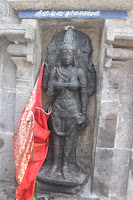
The
east facing vimana of the prime deity is made out of granite
substructure (from adishtana to
prastara) and brick super-structure (hara, griva and shikara) studded
with with stucco images. The external walls of the vimana has upana,
jagadi, tri-patta kumuda mouldings and can be termed as simple
Padabandha adhishtana. The pada of the vimana and ardhamandapa have five
deeply cut niches flanked by ornate pilasters. The niches on the south
and north ardhamandapa walls houses the Chola style idols of Vinayaka
and Durga respectively.
The southern vimana wall houses the sanctum of
the unique Chola period Lord
Rishaba Dakshinamurthy appear seated on His
Rishaba Bull vahana (mount) on a hill instead of under the Kallala tree (Banyan tree).
Sthanaka Vishnu appear in the niche of the western vimana wall. Brahma
appear in the niche of the northern vimana wall.

The east facing shrine of Goddess
Soundaryanayaki aka Kanarkuzhali,
the consort of the presiding deity, is located on the left side of the
prime sanctum. Like the main sanctum this also built with granite and
the super structure (hikara, griva and stupi) with brick and mortar.
Goddess
Soundaryanayaki appear in a standing posture. The niches are bereft of any deities / sculptures.

The
shrine of Lord Muruga appears behind the prime sanctum. The Lord's left
hand shows Narasa mudra and right had abhaya mudra. Navagriha shine is
located just before the Durga. There is a separate shrine for Aiyanar.
The seven Sapta Matrika idols and the Yoga Guru (Virabhadra) are
arranged in a row at the north corridor. Also there is the unique
Pallava Durga idol.
Tirumundeeswaram is the
51st shrine glorified by Devaram hymn (தேவார பாடல் பெற்ற தலம்) and the 19th among the 22 Shiva shrines of nadu
nadu canonized by Devaram. The Lord is revered by the Devaram hymns of Thirunavukkarasar aka A
ppar.
 |
| Saptamatrika & Yoga Guru |
 |
| Durgai (Pallava) |
 |
| Bairavar |
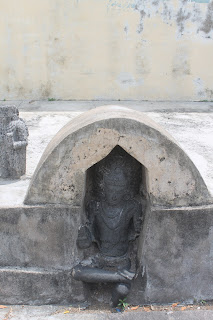 |
| Dakshinamurthi (Parantaka I) |
History
Parantaka
Chola I (முதலாம் பராந்தக சோழன்) (907 - 955 A.D.) further extended the Chola territory founded
by Vijayalaya Chola (விஜயாலய சோழன்) and Aditya Chola I (முதலாம் ஆதித்த சோழன்). He earned the title 'Mathirai
konda Koparakesari' (
மதிரைகொண்ட கோப்பரகேசரி) at the third year of his rule (910 A.D.) after
invading Maravarman Rajsimha II 's (இரண்டாம் மாறவர்மன் இராஜசிம்மன்) Pandya kingdom and capturing its
capital city 'Madurai.' After loosing the first battle, Maravarman
Rajsimha II sought the help of Ilam (ஈழம்) (Sri Lanka) king and an Ilam army
under the command of Chakka Senapati (சக்க சேனாபதி) came to Tamilakam to support
Pandya. Parantaka I at the eighth year of his rule (915 A.D) defeated
the combined army of Pandya and Ilam in Vellore (வேலூர்) by Parantaka's generals
Pazhuvettaraiyar (பழுவேட்டரையர்) and Kandan Amudanaar (கந்தன் அமுதனார்). This victory earned Parantaka the
title Parantaka got a title - 'Maduraiyum Eezhamum Konda Kopparakesari'
(
"மதிரையும் ஈழமும் கொண்ட கோப்பரகேசரி") as well as usurping more Pandya regions to Chola territory.
The Chola dynasty received support from many local kings and feudatories. During the reign of Parantaka Chola I Pazhuvettaraiyar (பழுவேட்டரையர்) and
Kodumbalur Velir (கொடும்பாளூர் வேளிர்) extended their support to the Chola king.
Pazhyvettaraiyars have their origin from kerala. They also made their
presence in the heartland of Chola i.e, Kila-Paluvur (கீழப்பழுவூர்) and Mela-Paluvur (மேலப்பழுவூர்),
in the Udaiyarpalayam taluk of the Tiruchirapalli district and managed
to survive in very high ranks in the Chola kingdom.
Parantaka
Chola I had numerous wives, among whom no fewer than eleven come out in
the inscriptions: three of them were from Paluvettaraiyars' daughters -
Udaiya Pirattiyar Kokkilan Adigal (உடைய பிராட்டியார் கோகிலன் அடிகள்) daughter of the Chera king Rama Varma
of Kulasekara dynasty; Arumoli Nangai (அருள்மொழி நங்கை), the daughter of another Chera
king Paluvettaraiyar Kandan Amuthan, who ruled from west Paluvur of the
present Tirutchirappalli in Tamil Nadu bordering Kerala; Villavan
Mathevi (வில்லவன் மாதேவி) probably the daughter of the Venad King (வேநாட்டு அரசர்) of the Chera country.
Parantaka I had four sons i.e., Rajaditya Chola (இராஜாதித்ய சோழன்), Kandaraditya Chola (கண்டராதித்ய சோழன்), Arikulakesari aka Arinjaya Chola (அரிகுலகேசரி என்ற அரிஞ்சயன்) and
Uttamasseeli Chola (உத்தமசீலி சோழன் ). The Parantaka had Rajaditya, elder son and Kandaraditya
second son by Udaiya Pirattiyar Kokkilan Adigal and Arikulakesari aka Arinjayan, the third
son by Arulmoli Nangai.
Vijayaraghavadeva
(A.R. No. 169 of 1912), believed as the Chera contemporary of Parantaka
Chola I, is considered as the successor of Sthanu-Ravi the
friend and ally of Aditya I (S.I.I., Vol. III, No. 89).
The Krishna II (இரண்டாம் கிருஷ்ணன்)
(878–914 A.D.) Rashtrakuta king married his daughter to Adiya Chola I (
870–907
A.D.). Aditya Chola I had his son Kannaradeva (கன்னரதேவா) aka Krishna III (மூன்றாம் கிருஷ்ணன்) by
Rashtrakuta princess. After the demise of Aditya Chola I, Parantaka Chola
I ascended the Chola throne in 907 A.D. instead of Kannaradeva, the
grandson of Krishna II, the half-brother of Parantaka I. Rashtrakuta
king Krishna II decided to force the issue of his grandson and therefore
waged a war against Parantaka Chola I with the support of his feudatory
allies i.e., Banas and Vaidumbas. However Parantaka I thwarted Krishna
II and his allies in a pitched battle at
Vallala aka Tiruvallam (presently located at Vellore district) some time
between 911 - 912 A.D. The invaders fled back to Rashtrakuta court and
influenced Kannaradeva aka Krishna III to wage a war against Parantaka
Chola I.
The situation increased responsibility of
increasing the defence at the north-west gateway (வடமேற்கு எல்லை). The demise of
Parantaka Chola I 's loyal vassal Ganga Pritvipati II (கங்க அரசன் இரண்டாம் ப்ரிதிவி) in 940 A.D. has
also weakened the defence in the north-west gateway. The Rashtrakuta
army under the command of Krishna III mounted attacks
into the north-west gateway and its contiguous territories between 940
and 949 A.D. However Parantaka Chola I was very much conscious about the
repercussions and made his defence preparedness against emergency
situations. At Mudiyur (முடியூர்) aka Mouli Gramam in Tirumunaipadi Nadu he maintained a strong army
garrison (படைவீடு) under the command of his elder son Rajaditaya Chola. The army was stationed
in the forms of local garrisons and in cantonments called
Kadagams (கடகம்).
He was ably supported by his brother Arikulakesari aka Arinjaya Chola.
The arrangements served its purposes for a quite a number of years.
Vallabhan Kumaran (வல்லபன் குமரன்) aka Vellan Kumaran (வெள்ளான் குமரன்)
or Vellankumaran (வெள்ளாங்குமரன்) was the son of Rajasekharan, the first
king (feudator) of Valluvanadu as well as the Governor of Vallabha
Rashtra under Chera king. There are inscriptions on king Rajasekharan.
From incriptions it is learned that Vellan Kumaran was the native of
Nandikkaraiputtur in Chera country (present Kerala). He also served as
the general of the Chola Prince Rajaditya.
It was in
949 A.D. Krishna III invaded and received the support of his
brother-in-law and his Western Ganga feudatory Butuga II (இரண்டாம் பூதுகன்) in this battle.
Rajaditya faced the Rashtrakuta army and the decisive battle was fought
at Takkolam (தக்கோலம்), small town located 14 km south-west of present Arakkonam
town. It was well contested battle and the Chola cause suffered mainly
on
account of a chance arrow shot by Butuga having fatally wounded
Rajaditya. Atagur (a place near Mandya taluk, Mysore ditrict,
Karnataka) inscriptions of Krishna III and Butuga II (இரண்டாம் பூதுகன்) serve a an
important source telling how the Chola prince was treacherously
murdered. Krishna III asumed the title of the conqueror of 'Kanchi and
Tanjore.'
The inscriptions of Tiruvorriyur provides the narration about Vallabhan
Kumaran, who was feeling guilty for his failure in saving the life of
the Chola prince in Takkolam war. As a result he decided to renounce his
worldly life and assumed the ascetic order. This Vallabhan
Kumaran was known as Chaturana Pandithar (சதுரான பண்டிதர்)
Inscriptions:
 |
| E-stamping (2) |
 |
| E-stamping (1) |
From the 9th to 16th century CE, the temple was under the patronage of successive prominent South Indian dynasties such as the Rashtrakutas, the Gangas, the Cholas, the Hoysalas and the Vijayanagara rulers.
Plenty of Parantaka Chola I inscriptions are found in Sivalokanatha Temple complex.
- A 23rd regnal year inscription on the southern wall
of the vimana of Sivalokanatha records the gift of 90 sheeps for a
perpetual lamp by Tirumunaipadi Nattar. (S.I.I No. 180 of 1906).
- Another 24th year regnal year inscription of the
same Chola ruler on the western wall of the vimana registers a sale of
land to the temple of Sivalokanatha (S.I.I No. 181 of 1906).
- Paranthaka Chola I 29th regnal year inscription
(S.I.I No. 182 of 1906) on the southern wall of of the vimana of
Sivalokanatha records about the provision made for burning perpetual
lamp in the temple of mulasthanattu-Mahadeva of Sri-Arruttali at
Tirumudiyur by Kari Piraman (காரி பிரமன்), a servant of prince Rajadittadevar.
- Some other 29th regnal year inscription of
Paranthaka Chola I (S.I.I No. 183 of 1906) on the southern wall of the
vimana enters a gift of gold for burning a perpetual lamp in the temple
of mulasthanattu-Mahadeva of Sri-Arruttali from the interest by a
person and his name is not comprehensible from the inscription.
- Yet another 29th regnal year inscription of
Mathiraikonda kopparakesari (Paranthaka Chola I) (S.I.I No. 183 of 1906)
on the western wall of the vimana registers the gift of gold coin made
by one Somadi (சோமாடி) and to light a perpetual lamp in the temple of
mulasthanattu-Mahadeva of Sri-Arruttali at Tirumudiyur from the
'Polisai' (பொலிசை) aka interest periodically accumulated over time. The bhttars
of Adhanur (ஆதனூர் பட்டர் ) were made responsible for supplying one 'uzhakku' ghee (உழக்கு நெய்) to the
temple.
- One Vellan Kumaran, a native of Nandikkaraiputtur,
Chera country, gifted sheeps for lighting a perpetual lamp in the temple
when he was staying in this temple as the general of the Chola Prince
Rajaditya.
- Another 31st regnal year (938 A.D.) inscription of
Parantaka I records the gift of copper bell stand to the temple of
Sri-Arruttali-Perumanadigal by some army men of Prince Rajaditya.
- The 32nd regnal year (939 A.D.) inscription of
Parantaka I records the gifts of gold and paddy made by Prince
Rajadityadeva to Sri-Arruttali-Mahadeva at Tirumudiyur through the
bhattars of Tiruvennainallur and Adhanur (திருவெண்ணைநல்லூர் மற்றும் ஆதனூர் பட்டர்கள்).
- One 35th regnal year (942 A.D.) incomplete
inscription (S.I.I No. 185 of 1906) of Parantaka I records the gift of
utensils to be used during worship in the temple of
Sri-Arruttali-Perumanadigal Probably by some army men of Prince
Rajaditya.
- Another 35th regnal year (942 A.D.) incomplete
inscription (S.I.I No. 187 of 1906) of Parantaka I records the gift of
utensils used during worship in the temple of
Sri-Arruttali-Perumanadigal probably by some army men of prince
Rajaditya.
- Yet another 35th regnal year (942 A.D. ) damaged
inscription (S.I.I No. 186 of 1906) of Parantaka I registers the gift
of a village tax-free made by the prince Rajadityadeva (probably with
the specified income fixed as paddy and gold) for the disbursals of
worship in the main shrine of the temple of Sri -Arruttali at Mudiyur.
- One more 35th regnal year (942 A.D. ) inscription
of Parantaka I registers the land endowment made made by one Kovadi
Udayar from Brahmapuri Nallurkandam in Mazhanadu for light two perpetual
lamps to Sri-Arruttali-mulasthanattu-Perumanadigal at Tirumudiyur.
- The 36th regnal year (943 A.D.) bilingual
inscription of Parantaka I on the northern wall of the vimana includes
15 lines in Sanskrit grantha language and 23 lines in Tamil language.
This inscription informs about Vellan Kumaran, a native of
Nandikkaraiputtur, Chera country, who built the granite temple of
Sri-Arruttali-Perumanadigal at Mudiyur. Vellan Kumaran occupied an
important position (மூலப்பிரித்தியர்) in Chola government and general of
the Chola army.
- The 39th regnal year (946 A.D.) unfinished
inscription (S.I.I No. 192 of 1906) of Parantaka I mentions of
prince Rajadittadevar and the temple of Sriyarruttali-Perumal.
- One more 41st regnal year (948 A.D.) inscription of
Parakesarivarman who took Madurai and Ilam (Parantaka Chola I) (S.I.I
No. 184 of 1906) records the gift of sheep for burning a lamp in the
temple of Sri-Arruttali Mahadeva at Tirumudiyur by Madevan Visameli, a
resident of Kurramangalam in Mangala-nadu.
 |
| E-stamping (3) |
Krishna III aka
Kannara (r.939
– 967 A.D.) was the last powerful and efficient king of the
Rashtrakutas. He held titles such as
Akalavarsha, Maharajadhiraja,
Parameshvara, Paramamaheshvara, Shri Prithvivallabha etc. This dexterous
military campaigner played a vital role in rebuilding the Rashtrakuta
Empire. He defeated Parantaka Chola I at Takkolam.
Three
inscriptions of Krishna III were copied from this temple. The 20th
regnal year (959 A.D.) inscription of
Krishna III (
Kannaradeva)
registers the gift of sheeps for lighting perpetual lamp. Another 22nd
regnal year (961 A.D.) incomplete inscription of
Kannaradeva is not
clear. Yet another 25th regnal year (964 A.D.) inscription of
Kannaradeva registers the gift made by
Sri Sundar Tiruvoyan, the king of
Vaidumba.
 |
| E-stamping (4): C.Veeraraghavan sir |
The 4th regnal year inscription of Chola prince Aditya
Karikalan aka Aditya II, the eldest son of Sundara Chola and the
brother of Rajaraja Chola I, registers the gift made for burning the
perpetual lamp. The 16th regnal year inscription of Rajendra Chola I
informs this village as brahmadeyam of Mudiyur-nadu (a
subdivision) of Tirumunaipadi Nadu in
Jayangonda-Solamandalam. The fourth regnal year inscription of Rajendra
Chola II records the tax-free land grant made by the citizens of
Kosapadi village made to the temple of Sri-Arruttali-Mahadeva in Parantaka chaturvedhi-mangalam of Mutiyur-nadu (a
subdivision) of Tirumunaipadi Nadu in Jayangonda-Solamandalam. The 10th regnal year inscription of Rajendra Chola II records the perpetual lamp gift made to Sri-Arruttali-Mahadeva in Parantaka chaturvedhi-mangalam by Sathi Periyan.
The fourth regnal year inscription of Kulotunga Chola I registers the decision of the sabha of Parantaka chaturvedhi-mangalam, of Mutiyur-nadu (a
subdivision) of Tirumunaipadi Nadu in Jayangonda-Solamandalam, to allow one Bhattanpuvan (பட்டன்பூவன்), after rechristening him as Parantaka Peraraiyan (பராந்தகப் பேரரையன்) to live in Ur Nattam (ஊர் நத்தம்) after receiving 20 kasu (coins) from him.
This
is incised immediately below No. 190 and gives no
introduction to the king. The 10th regnal year inscription (S.I.I. no. 190A of 1906) of Kulotunga Chola II records a gift of 72
sheep for burning “three fourth” of a perpetual lamp
in the temple of Sri Arruttali-Mahadeva by Selvan
Pallikondan alias Rajaraja-Periyaraiyan a kudippalli
(farmer) of Sevalaimedu in Kaliyur-kottam a division of
Jayagondasola mandalam to atone for the death of Madani
Kulatturan of the village, caused by him
[unconsciously?].
The 16th regnal year inscription (S.I.I. no. 188 of 1906) of Kulotunga Chola II records a gift of “there fourth” of a perpetual lamp
to the to the temple of Sri Arruttali-Mahadeva at
Parantaka-chaturvedimangalam (Gramam) by one periyan
Kanavadi of salur in Mangala-nadu of Vanagappadi a
division of Rajendrasola-valanadu in expiation of his
having shot by mistake (while hunting) a resident of
Enadimangalam (name not clear).
The third regnal year inscription of Rajaraja II registers that the lands belonging to temple Sri Arruttali-Aludaiyar in Kulotunga Chola Chaturvedhi-mangalam of Mutiyur-nadu were exempted from tax by one Anabhaya Kadavarayan aka Mohan Alapiranthan from Padikaval.
Three inscriptions of Jatavarma Sundarapandya I were copied from this temple:
The 15th regnal Year (1265-66 A.D.) inscription (S.I.I. no. 197 of 1906) of Jatavarma Sundarapandya I on the west and south wall of the Selvambika Shrine begins with the prasasti Samasta-jagad-adhara etc. The inscription, damaged in places, registers another endowment by the king of 9 ½ veli of land,
free of all taxes, for the expenses of the service
instituted in the temple of Bokkanankuduttaruliya-Nayanar (பொக்கனங் கொடுத்தருளின நாயனார்) in the name of the ruling king
by Vira-Pandya. Also refers about land grants made during the time of Kopperunjingadeva.
The 18th regnal Year (A.D. 1268-69) inscription (S.I.I. no. 196 of 1906) of Jatavarma Sundarapandya I on the south wall of the Selvambika Shrine begins with the Sanskrit prasasti of the king, Samastajagad-adhara etc. The record is damaged. It appears to register an endowment of land made by the king expenses of worship and offerings to the deity of the day of a special festival instituted in his name, and for the formation of a garden where the god was to be taken in procession on such occasions. Provision is also made for the daily supply of 200 lotus flowers to the temple and of 2000 lilies on festival days by the grant of 2-¼ veli of land to one Vikrama-pandyan alias Sri Mulasthana-Velan for the purpose. The god is called Sriyarruttali Mulasthanam-Udaiyar Bokkanankuduttaruliya-Nayanar (பொக்கனங் கொடுத்தருளின நாயனார்).
The 19th regnal Year (A.D. 1269-70) inscription (S.I.I. no. 198 of 1906) of Jatavarma Sundarapandya I on the north and west walls of the Selvambika Shrine begins with the Sanskrit prasasti of the king, Samastajagad-adhara etc. It is damaged in the middle portion. It registers another endowment of land tax-exemption by the king. However, the extent of the land and the purpose of the gift are missing. Out of this land one veli was to be set apart as jivita for Vikrama-Pandyan alias Sri Mulasthana-velan (mentioned in No. 196 above) for a (further) daily supply of 1200 lotus flowers to the temple.
Reference
- Ancient
Indian History and Civilization ed.2. By Sailendra Nath Sen. New Delhi,
New Age International Publishers, 1988. pp. 479 - 480.
- Chronological
history of Malabar: Ancient political history of Malappuram,
Valluvanad. ( http://c-radhakrishnan.info/malabar.htm )
- Treasures of Chola Empire in Cauvery Delta: Veera Narayana 'Veeranam' Lake. Prasannasankar. Jul 19th, 2015 in Indiamike.com (http://www.indiamike.com/india/tamil-nadu-f40/treasures-of-chola-empire-in-cauvery-delta-t161671/5/)
- Lecture on the temple by Dr. Padmavathi Anaiappan, retired Senior Epigraphist, Tamil Nadu State Archaeology Department, Chennai.






